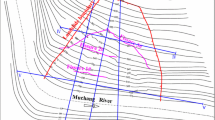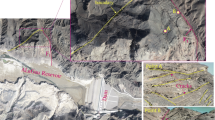Abstract
The Yudonghe landslide is located in a upcoming reservoir region of a 233-m-high Shuibuya rockfill dam, 2,300 m away from the dam site. It consists of a massive landslide with upper and lower segments and two secondary slides, i.e. an eastern secondary slide and a western secondary slide. In this paper, values of factor of safety (FS) for various masses were calculated in a scenario of reservoir impounding-induced increase in groundwater levels, using a method of three-dimensional (3D) limit equilibrium. Results showed that the smallest value of FS for the massive landslide is 1.12 computed on the presupposition of reactivating along a bottom slide zone in case of an earthquake. The smallest FS value of the lower slide mass is 1.12 in a possible direction, given earthquake occurrence and a groundwater level of 225 m above the sea level. This FS value shows that the lower slide mass is stable in case of groundwater increasing. In addition, by the calculation of the 3D limit equilibrium method, the FS value of the east secondary slide is approximately 1.0 in different groundwater levels under consideration of earthquake occurrence, which reflects that this mass is prone to reactivate when external factors are taken into effect.







Similar content being viewed by others
References
Chen WF (1975) Limit analysis and soil plasticity. Elsevier, New York
Chen RH, Chameau JL (1983) Three-dimensional limit equilibrium analysis of slopes. Geotechnique 33:31–40
Chen ZY, Wang XG, Haberfield C, Yin JH, Wang YJ (2001) A three-dimensional slope stability analysis method using the upper bound theorem. Part I. Theory and methods. Int J Rock Mech Min Sci 38:369–378
Dai FC, Deng JH, Tham LG, Law KT, Lee CF (2004) A large landslide in Zigui County, Three Gorges area. Can Geotech J 41(6):1233–1240
Duncan JM (1996) State of the art: limit equilibrium and definite element analysis of slopes. J Geotech Eng 122(7):577–596
Feng SR, Feng DX, Ge XR (1999) 3D limit equilibrium method for slope stability and its application. Chin J Geotech Eng 21(6):657–661
Hoek E (1987) General two-dimensional slope stability analysis. In: B rowm ET (ed) Analytical and computational methods in engineering rock mechanics. Allen & Unwin, London, pp 95–128
Hungr O (1987) Extension of Bishop’s simplified method of slope stability analysis of three dimensions. Geotechnique 37:113–117
Hungr O, Salgado FM, Byrne DM (1989) Evaluation of a three-dimensional method of slope stability analysis. Can Geotech J 26:679–686
Hutchinson JN, Sarma, SK (1985) Discussion on three-dimensional limit equilibrium analysis of slope. Geotechnique 35:215–216
Kiersch GA (1964) Vaiont reservoir disaster. Civil Eng 34:32–39
Lam L, Fredlund DG (1993) A general limit-equilibrium model for three-dimensional slope stability analysis. Can Geotech J 30:905–919
Michalowski RL (1980) Three-dimensional analysis of locally loaded slopes. Geotechnique 39:27–38
Ministry of Hydraulics and Hydroelectrics (1978) National standard of the People’s Republic of China SDJ10-78: seismic design code of hydraulic structures
Petley D (2006) The Vajont landslide. Available at: http://www.land-man.net/vajont/vajont.html. Accessed on June 17, 2006
Sarma KS (1979) Stability analysis of embankments and slopes. J Geotech Eng 105(12):1511–1524
The Qingjiang Geological Survey (1997) Geoenviromental reconnaissance and study around the planned site of Shuibuya hydropower station on the Qing River. Special Report (unpublished)
Wang HB (2001) Landslide visualization and its stability analysis using 3D equi-librium methods: a case study. Ph.D. thesis, China University of Geosciences, Wuhan
Wang FW, Zhang YM, Huo ZT, Matsumoto T, Huang BL (2004) The July 14, 2003 Qianjiangping landslide, Three Gorges Reservoir, China. Landslides 1(2):157–162
Wang HB, Xu WY, Xu RC (2005) Stability evaluation using back propagation neural network based on the mechanism analysis: a case study in Shuibuya dam region, China. Eng Geol 80:302–315
Wieczorek GF (1996) Landslide triggering mechanisms. In: Turner AK, Schuster RL (eds) Landslides investigation and mitigation. Special Report 247. Transportation Research Board, National Research Council, Washington, DC
Xu RC (1998) Geoenvironmental study in the Shuibuya dam region. Chin J Yangtze River 29(8):15–17
Acknowledgements
Support from the Yangtze River Water Resources Commission, particularly the help from Prof. Shutian Suo, was gratefully acknowledged. This work was partially supported by the funding from National Nature Science Foundation of China (no. 50539110 and 40772170) and Ministry of Science and Technology (no. 2006BAC04B05). Part of the work was kindly carried out by Mr. C.J. Zhao.
Author information
Authors and Affiliations
Corresponding author
Rights and permissions
About this article
Cite this article
Wang, H.B., Xu, W.Y., Xu, R.C. et al. Hazard assessment by 3D stability analysis of landslides due to reservoir impounding. Landslides 4, 381–388 (2007). https://doi.org/10.1007/s10346-007-0095-y
Received:
Accepted:
Published:
Issue Date:
DOI: https://doi.org/10.1007/s10346-007-0095-y




